This is the second in a two-part series of articles on biological individuality. In last week's post, I discussed an array of biological examples that blur the line of what it means to be an individual. You can read it here.
In this article, I'd like to draw upon the examples that I talked about last week and try and bring it all together. Emphasis on try, we are only really beginning to understand these things.
This was a bit haphazard last time because we didn't really know what criteria we should look for when defining an individual. This time, I'll give a bunch of yardsticks that we can use to measure individuality and see how they hold up against our menagerie of examples. Some fare better than others.
By the end, you'll hopefully be familiar with two promising frameworks for moving forward with the problem of biological individuality.
Table of Contents
- Replicators and memes
- Boundaries, sets and herding cats
- Interlude: The Ship of Theseus
- Informational individuals
- Darwinian individuals
- Further reading
Replicators and memes
An intuitive starting place would be to call an individual 'something that replicates itself.'
This is probably the first axiom that people turn to when asked to define what life is. It is one of the R's in MRS GREN and all things that we call 'life' here on Earth reproduce in one way or another.
So replication seems to be a necessary condition for individuality. However, this is definitely not enough, primarily because replication is sometimes very hard to define.
If you smash a rock in half, did it just replicate? Or if a cloud tears in half does that count as replication? Even more abstractly, if you are sitting in class and copy down a teacher's notes, did the notes just replicate themselves? Which of these things are individuals?
As evolutionary biologist Richard Dawkins explains in his 1976 book The Selfish Gene, ideas can be replicators. In turn, the spreading of ideas can therefore be a form of evolution. He named it cultural evolution, because every time we spread an idea, we are spreading a tiny unit of culture.
For instance, when you suggest to a friend to meet up for coffee, you have not only replicated an idea from your mind to theirs, but you have also transmitted a unit of culture.
Dawkins also coined a nice term for such a unit of culture - a meme. Yes this is the origin of the word meme, a cultural equivalent for a gene.
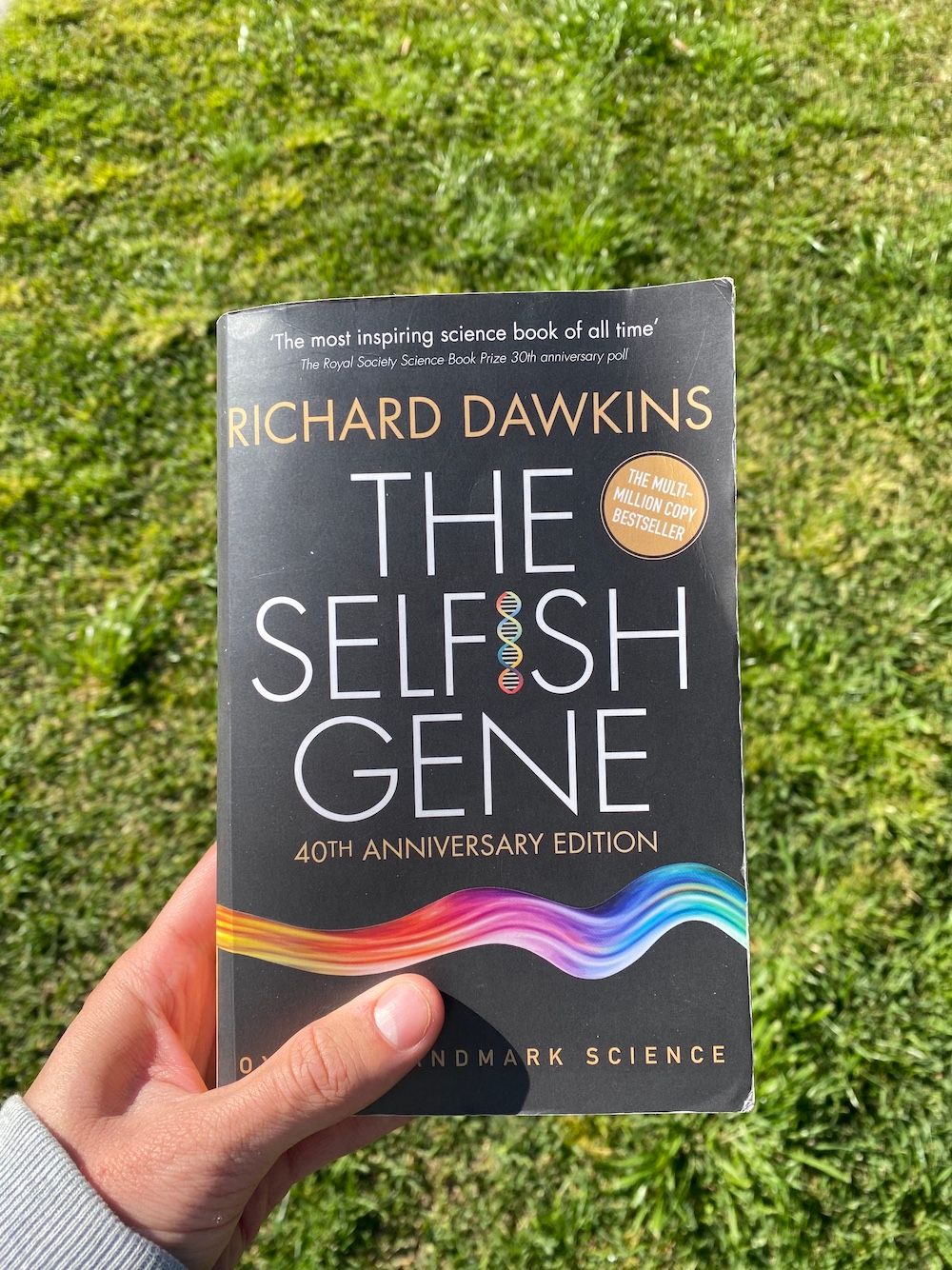
But is this really the best way to define an individual? Probably not.
Think back to the example of the slime mold. The whole slug reproduces as a fruiting body but the offspring then live as single-celled amoebae, dividing independently via mitosis. Not as a slug. So which one is the individual: the slug, the amoeba or both?
This question cannot be resolved with a replicator framework alone. We need something else.
Boundaries, sets and herding cats
The mathematician or the immunologist might try the following. Define an individual as a bag of self-things and define everything else as non-self things (aka the environment). In math-speak this would be defining a set and a set complement.
The immunology comes from the fact that our immune systems are usually pretty good at differentiating self-cells (that they shouldn't attack) and non-self foreign cells (that they should attack).
How does this framework stand up? Also not very well, because it doesn't solve anything. Take a human body with our gut microbiota. Should these little guys go in the self bag or the non-self bag? Again, the answer is not really very clear. If we wanted to fully embody this approach, each time we find a potential individual, we'd just have to make an arbitrary judgement call on whether something is self or non-self.
What if we tried something similar, but not quite as extreme and just defined an individual by a physical boundary. Everything within the barrier of your skin is apart of you and everything beyond it is not.
This works nicely for contiguous individuals like humans and plants but what about Pando? Last time we came to the conclusion that even though it was disconnected, it ought to count as one huge individual. Where then would its physical boundary lie?
I think it is quite clear that a pattern is emerging. All attempts to define individuality discretely are bound to fall apart eventually. There aren't any boxes that we can come up with to separate individuals from non-individuals concretely.
We have to think continuously. No boxes, otherwise we will end up trying to herd cats. In fact, herding cats is pretty much what we have been trying to do up until now, with little success.
This is the very conclusion that most philosophers and biologists have come to in the past decade, but how exactly we should define the continuums is still unresolved. I'll discuss two of my favourites.
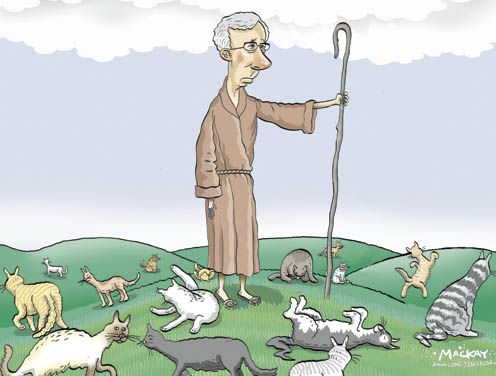
Interlude: The Ship of Theseus
Before I get into the next section, I think it's about time that I talk about the Ship of Theseus. This was an ancient Greek thought puzzle designed to investigate the metaphysical nature of individuality.
It goes something like this. After successfully defeating the minotaur, the great Greek hero Theseus sailed back to Athens . There, his ship was put on display, celebrating his triumph. As time went on, some of the ship's parts began to get mouldy and decay. As they did, the Athenians replaced each part of the ship, piece by piece. After many years of this, eventually every piece on the ship was non-original.
Is this completely restored ship still the same Ship of Theseus?

This thought experiment has stood the test of time and many philosophers have had a go at attempting to explain the puzzle. I won't go into these here. But this is not a puzzle that is purely bound to the philosophical realm. It also extends to biology, and in fact, to ourselves.
Every second, about 1 million of your cells die. These are obviously constantly replaced, but over time, this adds up. After about 10 years, all of your cells will be completely different to the cells you had 10 years ago. You will have been fully Ship of Theseus'ed.
So does this mean that the person you are today, and the person you were 10 years ago are different individuals? I think at this point in our discussion we can realise that this question itself is misguided.
Informational individuals
A better way to think of both the the Ship of Theseus and the cells in our body ourselves are as systems. There is no point at which one individual ends (in time or space) and another begins. Everything fades into one another as one whole system.
Now this finally seems to be a reasonable way of moving forward.
Rather than focusing on boundaries of individuality, we can look at how individuals, in a very broad sense of the word, function in nature. Individuals are now not conglomerates of matter, but are systems that process information. This information can come from two sources:
- Past instances of the system and,
- The environment.
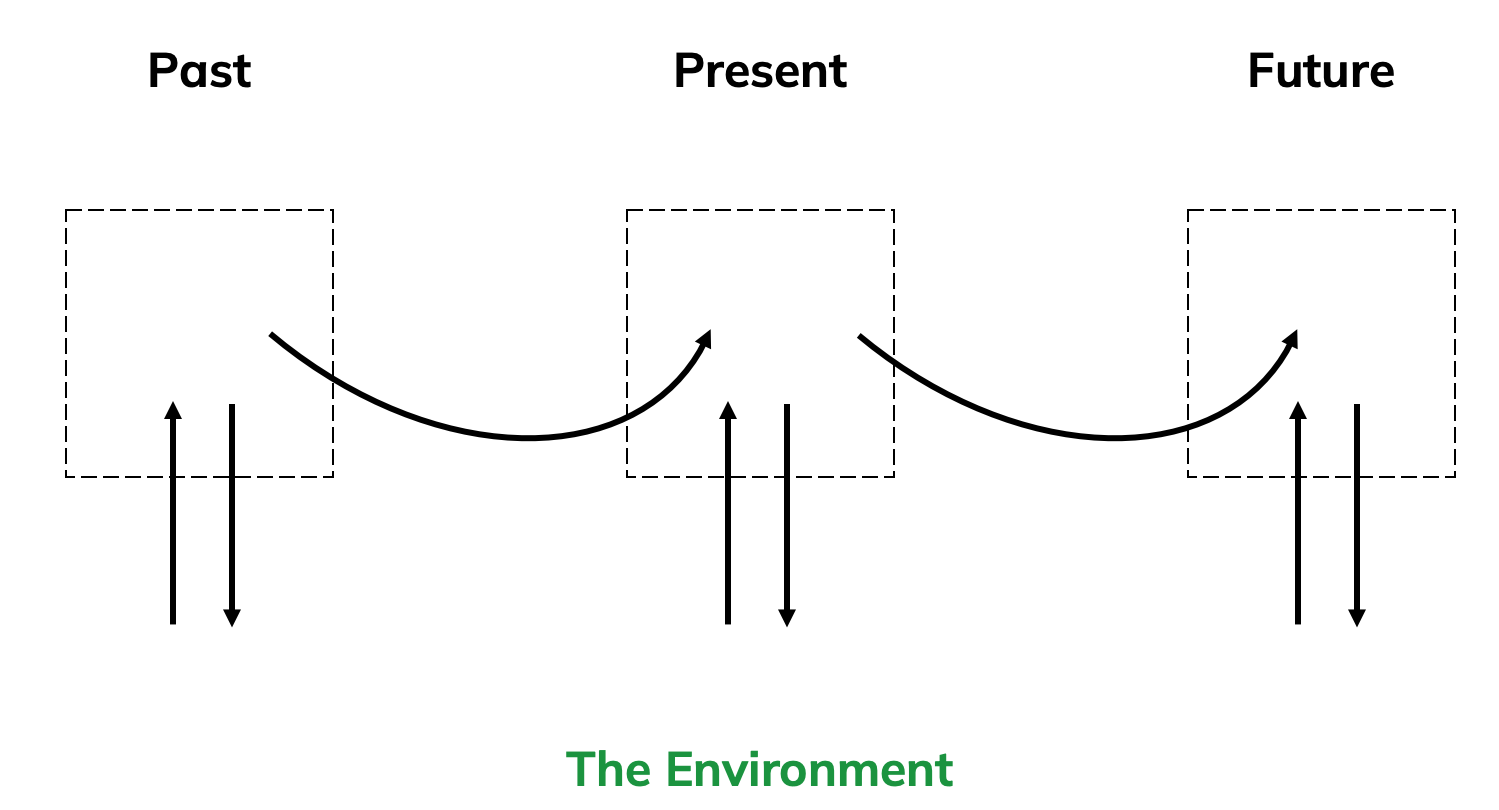
Information can also come in all sorts of forms. For Theseus' ship, there are two key types of information flows into and out of this system.
First, we can think of how information in the form of matter moves. It comes into the system in the form of new planks, and leaves as mouldy planks.
Second, information of the form of the ship also flows through time. When a builder puts a new plank in, he must know where to put it. The information to do so comes from the past form of the ship. Else, he wouldn't know where to put it.
For us a similar thing happens, just in a more complex manner. Information flows into your body in the form of food and water, is processed within you, and is then excreted. Information also flows through time: you have memories of what you did yesterday and can act on this information to change your behaviour today.
There are no clear boundaries on where you end as an informational process.
If you tell someone to remember something for you, or write it down on a piece of paper, you have imparted information upon your environment that you can retrieve at a later point in time. In a sense, you have just extended your mind beyond the physical constraints of your bag of cells.

The first time I thought about this, I had a minor existential crisis. Suddenly you realise that your brain is really just a wet lump of protein, fat and other molecules. There is no reason for why it should be special and contain the limits of your mind.
We are bordering on entering a separate discussion on the philosophy of mind, dualism, reductionism and of course the big question:
What is consciousness?
But we'll leave that for another time.
With this perspective however, it is now much easier to take a nihilistic view of biology. There is nothing special about organisms. They are just processes like any other, constrained only by the laws of physics.
For instance, the process of cloud formation also follows the diagram I gave above. The form of a cloud is influenced by the new information it gets from the surrounding environment (new water molecules entering and leaving). And it is also influenced by its past forms: what a cloud looked like a moment ago will influence what it looks like in its present form.
As you can see, this definition is quite broad and all the examples from last week are counted as informational individuals. For the mathematician inside me, it is quite nice to have such a general categorisation, but some might argue that it is a little too broad.
Namely, one question that comes to mind is: how does evolution work without discrete individuals? Almost all of theories of evolution require this. We can take a look at a subset of these informational individuals to work this out.
Darwinian individuals
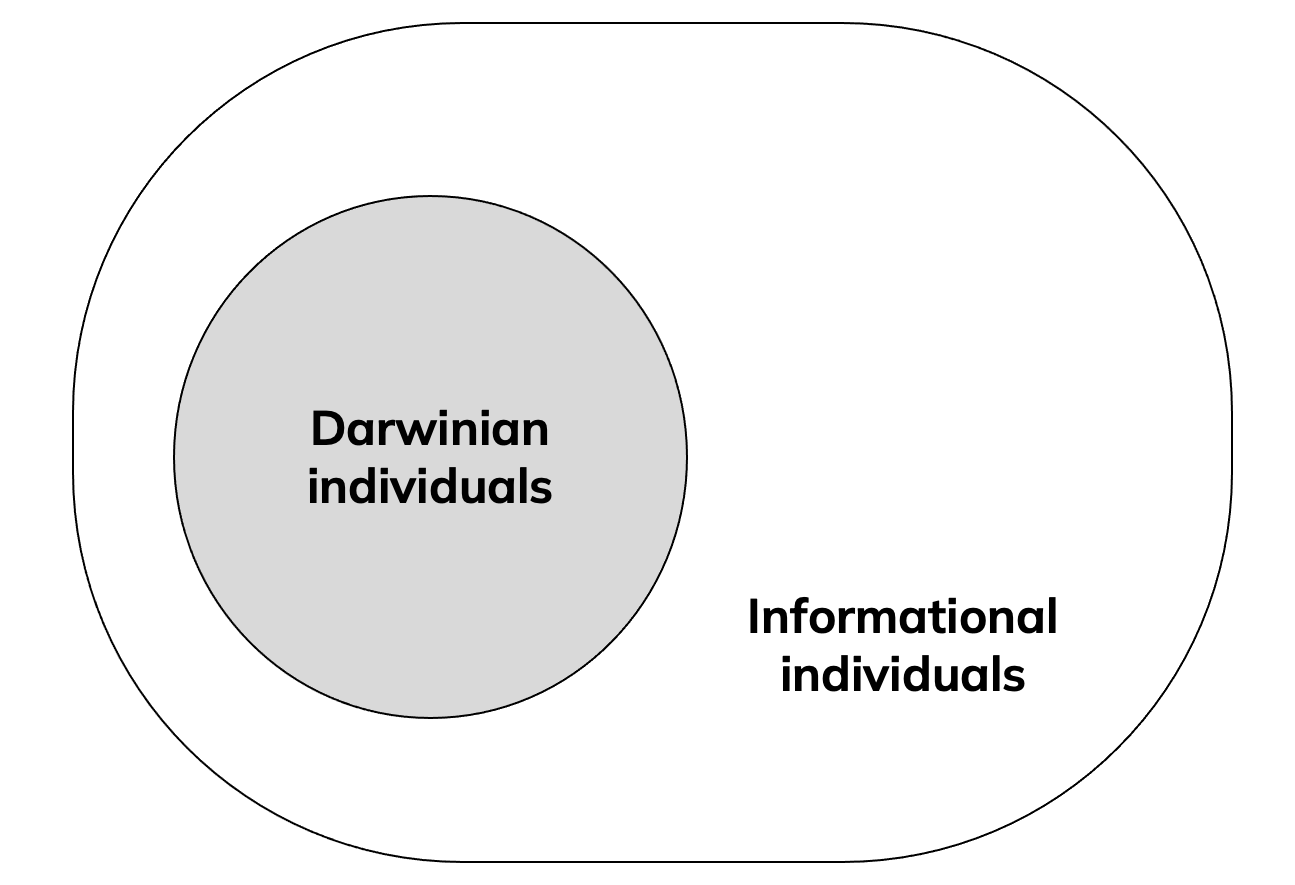
As we have seen above, informational individuals are pretty diverse. I mean, few biologists would consider clouds and humans to be comparable structures. But as systems that process information, they are.
That said, Australian philosopher of biology Peter Godfrey-Smith provided a nice framework for getting closer to 'normal' definitions of individuality in his book Darwinian Populations and Natural Selection. As the title implies, here we start not with the individual but one level up, looking at populations.
Specifically, populations that can evolve by natural selection. These are populations that satisfy the following conditions:
- There exists variation in characteristics among individuals in the population,
- Those individuals reproduce at different rates, depending upon their different characteristics,
- The characteristics are heritable from parent to offspring.
For populations that satisfy these conditions, we call the individuals that live inside them Darwinian individuals. They can evolve by natural selection. Unlike previous frameworks, Godfrey-Smith concedes that these are flexible and fluid. Some organisms might be closer to Darwinian individuals than others.
This helps us avoid the trouble we ran into when using replication/reproduction alone as the yardstick.
Doing a quick mental check through these three conditions, we can see that most things we think of as 'normal' biological individuals (humans, plants, bacteria, fruit flies) are counted. But how does this framework hold up for the trickier examples from last week?
The symbioses, viruses, corals and humans with microbiota, all have variation and can reproduce at different rates. So conditions 1 and 2 are definitely satisfied. As for condition 3, this is usually satisfied but there are some exceptions where parent-offspring lines cannot be established.
For instance, imagine we start with a parent coral together with its symbiotic algae. Say for whatever reason the parent then expels these algae (probably due to warming oceans). The parent then might reproduce to have offspring which do not have algae. Following a cooling of the ocean, algae may then reenter the offspring coral:
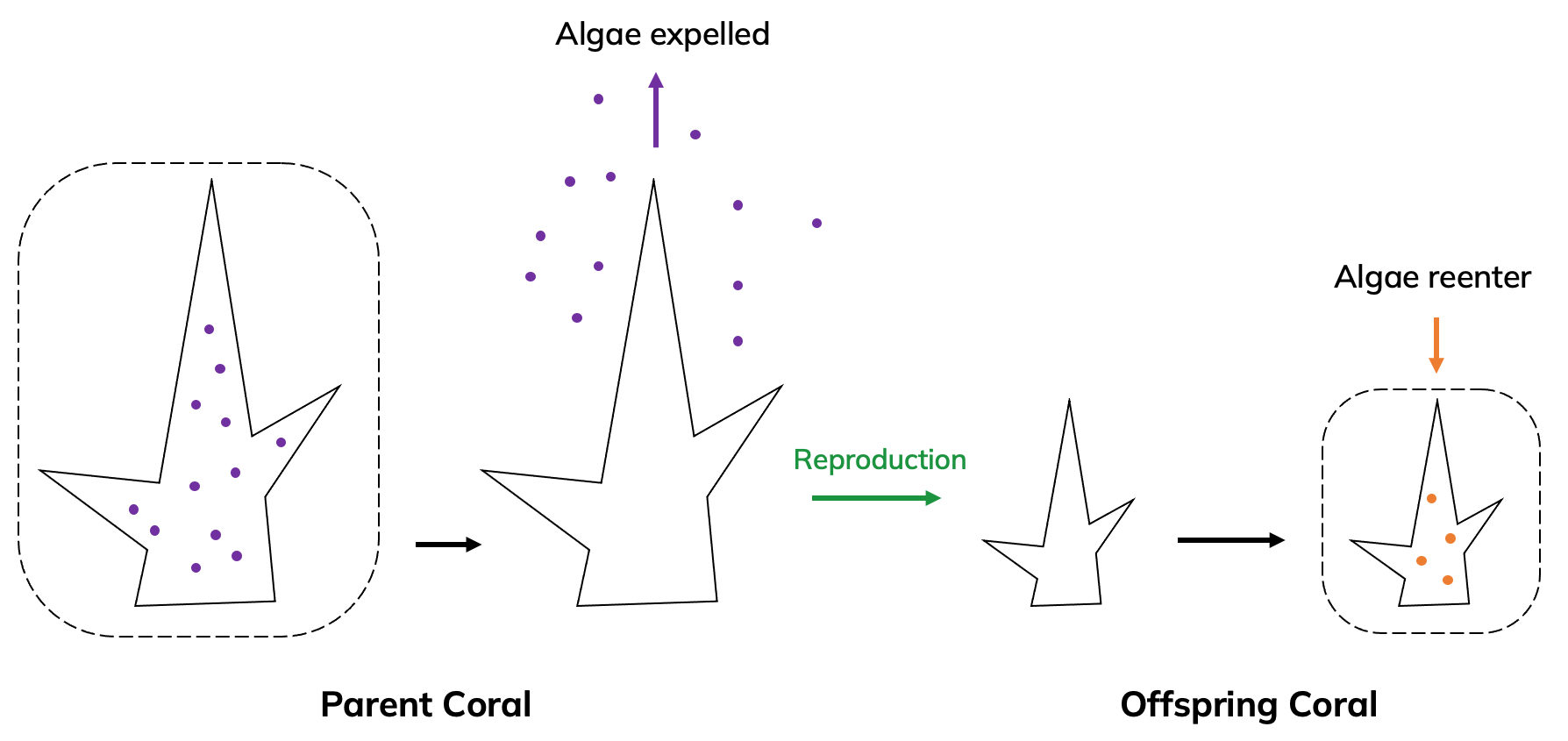
In this case, parent-offspring lineages have been broken since the purple algae above are different from the orange algae that reenter the offspring. So these coral holobionts (coral + algae) are not Darwinian individuals.
This makes sense. You can't have natural selection without inheritance.
Below is a quick summary table for the rest of the examples from last week. Some of these categorisations are pretty arbitrary and that's okay. As I said, the line is sometimes blurry and some of you may disagree with my choices.
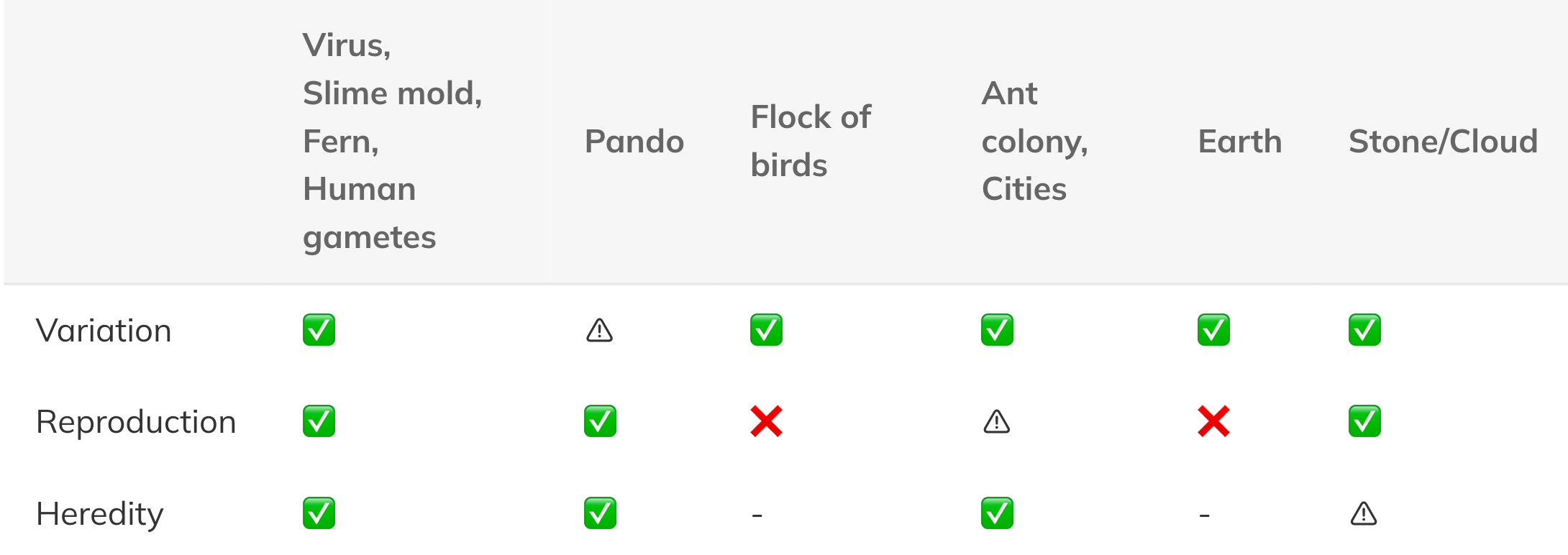
So the virus, slime mold, fern and human gamete seem to be Darwinian individuals, whilst the situation is more complex for the others.
Pando is a maybe on variation at the tree level, because its reproduction system (cutting roots) produces clones. But over time, these clones might accumulate mutations to allow for natural selection. And at the forest level, Pando satisfies all three conditions.
Neither Earth nor a flock of birds can reproduce in a reasonable manner so these are not Darwinian individuals. In this case, the flock of birds is closer to being a reproductive individual but not as close as an ant colony or a city. Here, is it easier to distinguish when reproduction has occurred because we can see the construction of a new physical city/colony.
Some stones break easier than others (variation + reproduction) but these descendant stones tend to look very different from their parents. Namely, they have to be much smaller by necessity. So inheritance is quite poor.
Conclusion
There is a lot to explore with both Darwinian and informational individuals, and I've left a few links below if you're interested to read/learn more. Both of these frameworks have only been developed pretty recently, which is kind of surprising given how old this question is. Ship of Theseus and all.
Philosophy of biology and the study of complex systems via information theory are moving forward at an ever accelerating rate. So I'm sure we will begin to understand individuals a lot better in the years to come.
Jake
Further reading


You can read the first part of this article here.
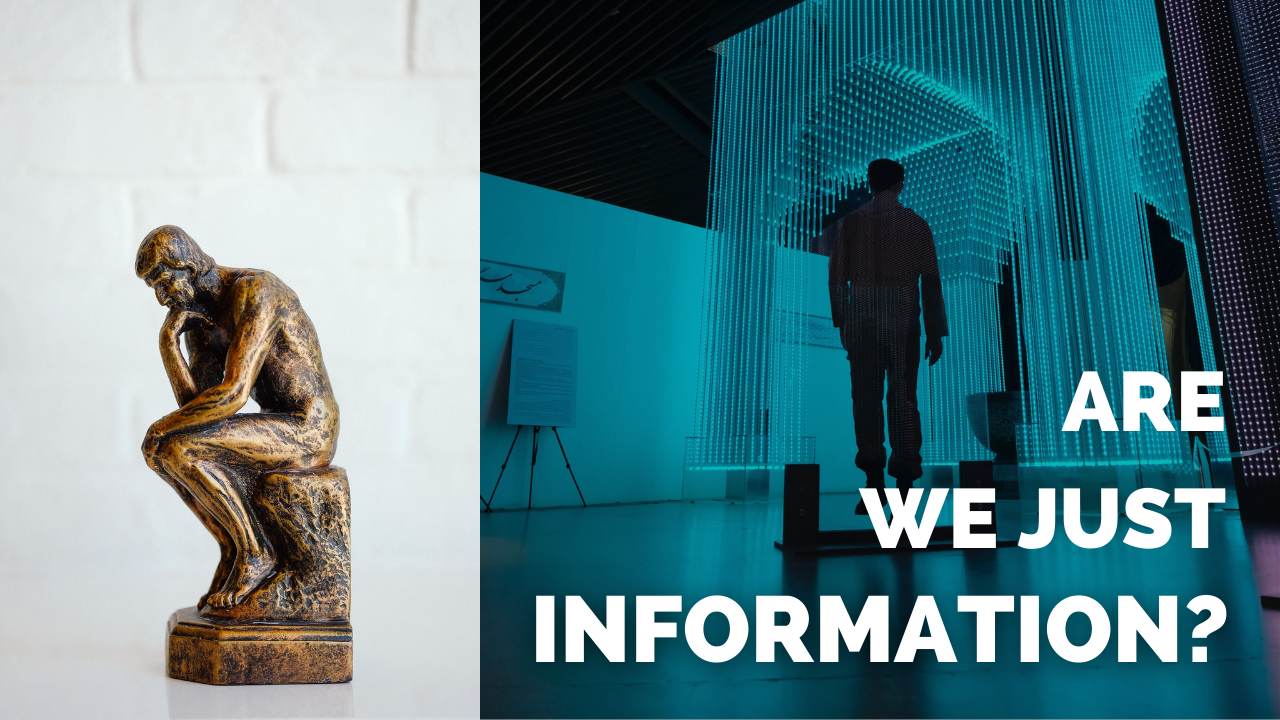



Member discussion: